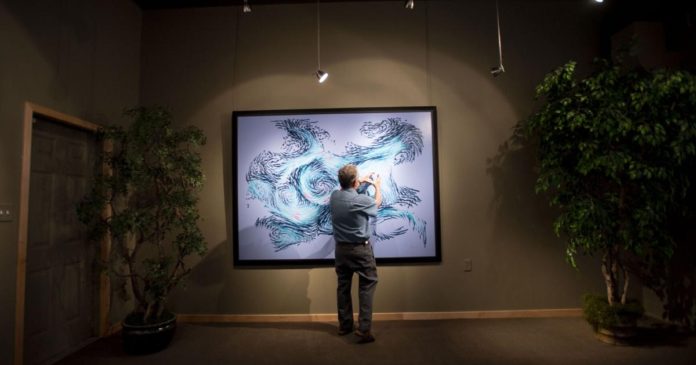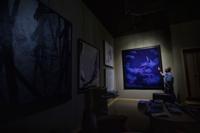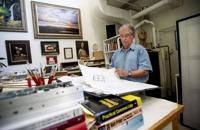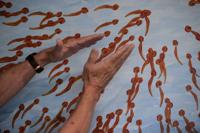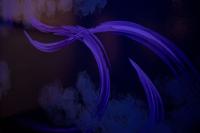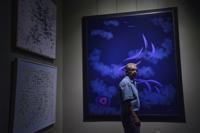LOVELAND • Don’t bother trying to understand it all. Just take it in.
The stacks of notebooks with pages of scribbles and detailed takeaways from years of art classes and museum visits. The piles of outlines that, to the untrained eye, look like complicated blueprints drawn by an architect. The many, many books, ranging from a Michelangelo biography to one titled “Self-Organization of Biological Systems.” The flow charts on whiteboards. The endless lines of code on a computer. The machine shop in the back and the paintings neatly hanging on the wall.
In inventing a robot that paints, Paul Kirby — seen here in his studio in Loveland — also invented the term “fusioneering,” which he says “allows you to cultivate many interests into something innovative and revolutionary.”
102921-fam-paul 01
And the robot holding a paintbrush.
One look at this room can be overwhelming for visitors, so Paul Kirby likes to start simple. It’s an old trick he learned as a ski instructor in Vail, when he realized every skier has slightly different goals for the slopes. It helped everybody if he just asked, “What do you want to get out of today?”
That’s what Kirby asks when people walk into his studio. He also asks how much time they have, because the full tour takes hours. People always stay longer than they planned. Time slips away when you’re picking Kirby’s brain and trying to understand some part of how it works. But before he answers questions, he wants to know. What would make this a great day for you?
It’s not like Kirby gets many visitors. No one just walks into his studio, because no one would expect this nondescript building to house masterpieces.
“I’ve been a hermit for over 20 years working here,” Kirby said. “That’s what I’m used to.”

Artist Paul Kirby stands next to a painting produced by Dulcinea, a painting robot he invented, at his studio in Loveland.
He’s the kind of hermit that is obviously a genius. Kirby was the kind of kid who taught himself Morse code and how to build a radio. He’s the kind of 71-year-old who seems like he’s lived seven lives.
He has worked as an engineer, served as an officer in the Air Force, studied at Harvard and got into tech investing. After retiring at 40, he never stopped wanting to learn. And when he wants to learn something, he goes all in.
Like when he took nine trips to the finest art museums in Europe to be a better painter. Like when he traveled to Australia to spend time with the world’s top fly fishermen to be better at catching fish.

Artist Paul Kirby stands next to Dulcinea, a robot he invented that can paint beyond what the human hand is capable of, at his studio in Loveland. It’s part of Kirby’s journey to fuse art and science.
His longtime friend and fellow artist Bill Moninger has seen Kirby’s endless curiosity turn into new obsessions over and over.
“He’s very curious about nearly everything, and he studies things to the nth degree,” Moninger said. “I think that’s just his nature.”
He offers an example, a simple one in the scheme of Kirby’s other creations. As Kirby got into fly-fishing, he didn’t settle for buying a pole. He taught himself how to make one out of bamboo.
“He’s like a dog with a bone,” Moninger said. “Whatever it is, he won’t let it go.”

Artist Paul Kirby paints one-of-a-kind art based on computer simulations he codes for his robot, Dulcinea, his journey to fuse art and science.
Kirby’s biggest bone to date is his most fascinating accomplishment and one reason anyone wants to visit his studio: He invented a robot that paints.
Again, that’s putting it simply. The 10-by-10-foot machine, which he named Dulcinea after a character from “Don Quixote,” took Kirby 10 years to design, partly because he had to teach himself robotics first. The other stuff he had to learn could fill a couple of college course loads: a little bit of mechanical engineering and some machine shop skills with a side of coding and artificial intelligence.
Plus, if he was going to tell a robot how to make art, Kirby had to learn art. Like, really learn art.
The result is what Kirby describes as an original artist, one who paints one-of-a-kind pieces. Kirby and Dulcinea act as partners, but Dulcinea is also an extension of Kirby, as he’s the one writing lines of code that tells Dulcinea what to do.
Dulcinea is powered by seven motors and has a flexible “hand” that mimics the movements of a human wrist. This is how Dulcinea can not only hold a paintbrush, but also create swirling brushstrokes beyond what’s possible for a regular ol’ human.

Dulcinea doesn’t just copy art Paul Kirby comes up with. Kirby types out a computer simulation, perhaps inspired by the swirls in his cappuccino or how ants follow breadcrumbs.
The Gazette
Dulcinea does more than that, so much that this is again where visitors tend to get overwhelmed. Moninger, whose studio is nearby, can attest to that after plenty of times seeing Dulcinea do her thing.
“It takes a different big brain to figure out how to do all that,” Moninger said. “And that’s what Paul has.”
Dulcinea changes paint colors, washes her brushes and seals paint containers. When a painting is done, she signs her name and turns off her power. Kirby isn’t steering the wheel.
“While that’s happening,” Kirby said. “I’m usually at home.”
He built the robot to be fully automated, so the painting often gets done overnight and without Kirby looking on.
A lot has to happen before Dulcinea is ready to paint something, though. She doesn’t just copy art Kirby comes up with. Kirby types out a computer simulation, perhaps inspired by the swirls in his cappuccino or how ants follow breadcrumbs.

Diulcinea is powered by seven motors and has a flexible “hand” that mimics the movements of a human wrist, providing the ability to create swirling brushstrokes beyond what’s possible for a human.
Each time the simulation runs with slightly different parameters, a slightly different outline for a piece of art shows up on Kirby’s computer. He then decides when to press the button that says, “Ship to robot.”
“So did I create that or not?” Kirby says. “I mean, that’s an interesting discussion.”
The robot is something to marvel at and so is the art it creates. Kirby displays Dulcinea’s beautifully abstract pieces in a next-door gallery.
Seeing these paintings is moving enough to make for a great day.
But maybe your goal for the day is to get the fuller picture. In that case, Kirby will tell you about some “aha” moments, which, because he’s a genius, he knew to listen to. And, because he’s a genius, he calls them epiphanies.
There were three big ones.
The first one was on Oct. 23, 1977, when Kirby went for a walk on Harvard’s campus and a question popped to mind: “What if I can combine something technical with something aesthetic?”
He raced to a nearby pizza spot to write down his thoughts. All they had, understandably, was a paper plate.
That paper plate, covered in pencil scribbles, hangs up today in Kirby’s studio.

Paul Kirby, at his studio in Loveland, stands in front of “Meditation Upon Death.” The painting was produced by Dulcinea, a robot artist he invented that paints one-of-a-kind art based on computer simulations coded by Kirby. He was trying to capture his love for his wife, Linda, and his sadness that she was gone.
Years later, Kirby visited a Leonardo da Vinci exhibit in Sweden. Here came the second epiphany, which also came in the form of a question: “What if Leonardo da Vinci were alive today and wanted to combine his love of machinery with art?”
Kirby thought, maybe, that someone like Leonardo would build a robot that paints.
The third epiphany appeared after Kirby built Dulcinea. A group of at-risk teenagers came to visit his studio. Kirby asked them what they like to do for fun, to which one girl replied, “I like to play in the mud.” All the other kids laughed, thinking maybe she was too old for such an activity. So the girl announced she liked computers, too.
Kirby quickly chimed in. “That’s brilliant,” he said. “Why don’t you put the two together? You could be an archaeologist or an anthropologist.”
This is when something else clicked for Kirby, how he could inspire others by sharing his journey.
Now it’s time for Kirby to tell you how each piece, each epiphany, comes together.
In inventing the robot, Kirby also invented the term “fusioneering,” which he says “allows you to cultivate many interests into something innovative and revolutionary.”
As a “fusioneer,” Kirby doesn’t settle for just painting or just robotics. To him, both passions are enhanced when they’re together. As his website says, “You become a fusioneer when you dig deep into your interests, blend them together, and introduce something unique to the world.”
He has a metaphor to help understand: Why would you just have a scoop of ice cream or a slice of apple pie if you could put them together to create something even more delicious?
And fusioneering fits with each of his three epiphanies, like a puzzle that’s finished after decades of faithfully picking up pieces here and there and hoping they someday fit together.
With the way Kirby fusioneers, he’s combining something technical with something aesthetic. Heck, it’s a good way of describing what Leonardo da Vinci did 500 years ago when creating something like the parachute. And fusioneering is what Kirby wants to encourage the next generation to do.
Kirby says combining his loves has helped him realize his dream. And he thinks this “fusioneering” concept could help others rethink having passions that seem to conflict.
“It’s not about me,” he said. “But I have to tell my story as a metaphor to inspire people to follow their own dreams.”
That’s Kirby’s “new phase.”
It’s why he hired a team to make a new website and funded a crew to film a minidocumentary about his work and life. The doc was shown at the recent Vail Film Festival.
In the documentary, author Michelle Auerbach spoke about how Kirby’s fusioneering shows that your heart doesn’t have to be separate from your work.
“Paul teaches us that we are capable of things that we never thought were possible,” she said. “That who you are as a person, showing up just as yourself and doing things that you care about is of enormous value.”
Moninger has taken away a few things from his friend, too.
“I’ve learned that you can always get better at whatever you’re doing,” he said. “And you can always look at it differently. It’s an eye opener to find out there’s more than one way to do something and express your talents.”
You don’t have to understand Kirby’s mind to understand his heart, and that it holds lessons, too.
When a heart breaks, even if it belongs to a genius, you don’t know how the pieces will scatter. This kind of random shattering could be the inspiration for another one of Kirby’s computer simulations. Instead he had to live it.
It was 2013, when he was to be married to a woman he loved named Linda. He remembers sitting down to dinner with Linda after work and looking out the window at the lake and saying, “We’re living the dream!” Four weeks later, she died unexpectedly.
Kirby did what he knew what to do with his broken pieces: try to make art out of them.
He, along with Dulcinea of course, spent years trying to capture the moment of death and how someone’s spirit rises to the sky. He was trying to capture his love for Linda and his sadness that she was gone.
Moninger stopped by to talk through dozens of drafts.
“He just kept experimenting until it was just right,” he said. “And I don’t mean almost right.”
Kirby said working relentlessly on the painting helped him feel close to Linda. And helped him heal.
Soon, he got it right.
Called “Meditation Upon Death,” the piece shows misty clouds and purple feathery strokes ascending up against a dark navy background.
When Kirby goes to show the piece to people, he starts with the room dark. He turns the lights on and gives the viewer a silent moment to look. Kirby doesn’t say anything either, but you can tell he’s looking at something he loves. Because it reminds him of someone he loves.
You don’t have to understand it the way Kirby does to see something beautiful.
It’s a painting, along with his others, that deserves to be seen by more. But Kirby says that doesn’t necessarily mean his paintings belong where the best art belongs.
“If you hang it up at a museum, it wouldn’t tell the whole story,” he said.
So, for now, the art stays near the robot and the computer that helped create them. They stay near Kirby as he creates more, serving as reminders of the times before that he’s fit all the pieces together.
As a visit with Kirby ends, he goes back to that same question.
“So, what do you think?” he asks. “Did you get everything out of this that you wanted?”
Even the question is one of Kirby’s lessons. If you start your day with a goal, you just might reach it.
“I know what my goal is,” he says. “It’s to inspire.”
Contact the writer: amanda.hancock@gazette.com
Credit: Source link

















